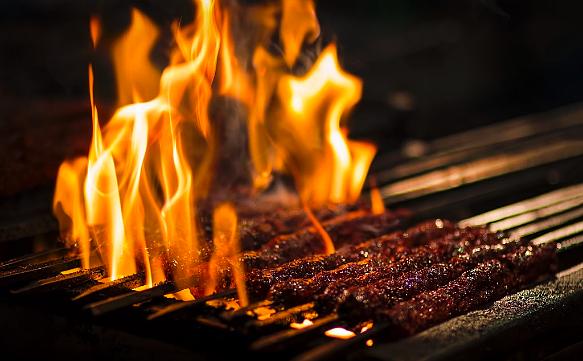KEBAB IN TURKISH CUISINE- Although kebab has an important place in Turkish cuisine, it has gained its deserved place maybe only in recent years. In recent years, the development of kebab restaurants and their transformation into stylish restaurants, the changes in the presentation of kebabs, of course, have been effective in them. Kebab attracts the attention of important chefs of world cuisines with its presentation as well as its history and taste.
While the discussions about red meat have been going on recently, experts explain that it is a very important food item if it is eaten in proportion to red meat, and that it is an important nutrient due to its strengthening feature, and its deficiency can cause serious problems. It becomes healthier. Especially the onion and garlic accompanying the kebabs are used as natural antibiotics for four seasons. When the pomegranate syrup, fruits and vegetables used in other kebab varieties are examined one by one, it is seen that the kebab combination is healthy.
KEBAB IN ANATOLIA- More herbs collected in the region are flavored with kebab. So much so that considering the Southeastern Anatolia region, kebab has been flavored with different spices even in physically very close cities. For example, kebab names are called Adana Kebab, Urfa Kebab, Antep style kebab. The hot spice used has also been decisive for kebab names over time. Hot kebab, hot kebab ... etc.
Over time, legumes have been put into use, and Simit kebab (Oruk kebab), in which fine bulgur is added, is one of them.
KEBAB IN OSMAN- When Osman Cuisine is the subject, one of the biggest discussions is whether there is Kebab in the palace cuisine during the Osman period. While "kebab", which is in our minds today, is served with meat and tomatoes, peppers, onions, parsley and sometimes radish, the definition of kebab in the Palace Kitchen is very different. Looking at the sources, it is seen that he was in the kitchen after the Fatih period.
One of the kebabs in the Palace Kitchen is that, according to written sources, Süd Kebab is also described as cooking the meat slowly with the help of a skewer and cooking the meat in the bottom of the pots filled with rice and cooking in this way.
Considering the definition of "Kebab", which is also mentioned at the beginning of the article, it is enough to be fried meat to be the dish made of Kebab. It is not necessary to have tomatoes, peppers, etc. in every kebab plate.
In addition, one of the most interesting points about kebab in the sources belonging to the Osman Palace Cuisine is that sometimes the meat is cooked on the handle of the eggplant instead of the shish and the kebab is made. One example of this is the cooking of kebab by passing meat pieces on the handle of a bay leaf.
Nowadays, when the culinary cultures are examined, the Kebab region belongs to a very wide geography, showing regional and regional differences. The differences in kebab cooking have created kebab varieties. Thanks to the use of vegetables, spices, greens and fruits, there are dozens of kebab types. Minced meat kebab with six paste, six paste cubed kebab, shepherd's kebab, tomato kebab, eggplant kebab, onion kebab, garlic kebab, keme kebab, new world kebab, apple kebab, sour apple kebab, quince kebab, mushroom kebab, minced meat kebab, yoghurt Kebab, Cubed Kebab, Seasoned Kebab, simit kebab, sour cherry kebab are some of the varieties.
KEBAB TODAY- Nowadays, when it comes to kebab, the kebab restaurants in cities and the main names of kebab come to mind. However, when examined in depth, kebab is a food culture that contains certain values. Even so, kebab is a kind of cooking way beyond meat. Chestnut kebab and cheese kebab are examples.
When the kebab is examined on the basis of regions and cities, it is understood that the form of kebab made from the materials used contains the local culture. While the use of fruit in kebab types is very common in Syria, especially in Aleppo cuisine, we see that it is very rare to use fruit in kebabs in other Anatolian cuisine cultures except Gaziantep cuisine. It can be said that some similarities between Gaziantep and Aleppo cuisine are due to the geographical proximity. While it is noteworthy that spices are determinant in Adana and Urfa cuisine, kebab is distinguished from others with its meat selection in some regions.
KEBAB IN GAZIANTEP- One of the first cities that comes to mind when talking about kebab today is of course Gaziantep. Gaziantep has a very wide eating and drinking culture as it is not only kebab but the only cuisine known as the city.Kebab has a very important place in Gaziantep, both the cooking method of kebab and the spices used in kebab and the salad to be served alongside the kebab. Serious attention is paid to drinks. Gaziantep is conservative about kebabs, the spice to be used in minced meat kebab is certain, how long the simit kebab will be cooked, and the seasoning of the meat to be used in kebab is certain. The continuation of traditionalism in these details shows the sensitivity of kebab making in Gaziantep.
In addition to all these, there are also varieties of kebabs cooked by ladies in the kitchen, which are called kebab in Gaziantep. Kazan kebab, bread kebab, gavur kebab, liver kebab, reed kebab, groom's kebab, finger kebab, Kilis kebab, Aleppo kebab, vegetable kebab, pistachio kebab, Indian kebab, tas kebab.
Butchers are also important in making kebabs in Gaziantep, to give an example, when ladies tell their butchers which kebab to cook, they buy the appropriate meat, and sometimes even meat for kebab is bought from the butcher. Ladies prepare their kebabs on trays at home and send them to the bakery of the neighborhood and cook their kebabs.
